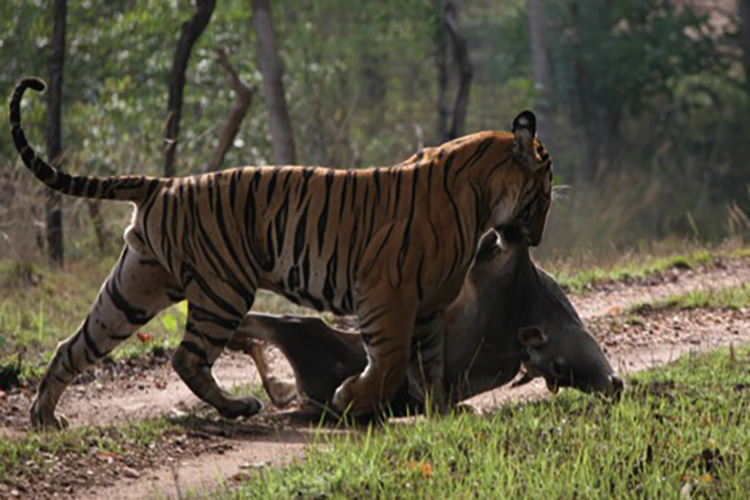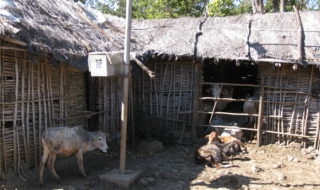Conservationists widen toolkit for predator management
A new UC Berkeley study shows that many non-lethal methods of predator control can be highly effective in protecting livestock from predators and in turn, saving predators from people

December 13, 2016
Top predators like wolves, bears, lions and tigers have declined dramatically around the world over the past century. One major driver of these declines is retaliatory killing by people following predator attacks on domestic livestock. This lethal approach to predator management is increasingly controversial not only because of ethical concerns, but also the role predators can play in healthy ecosystems. A new study involving researchers who are now at UC Berkeley shows that many non-lethal methods of predator control can be highly effective in protecting livestock from predators and in turn, saving predators from people.
The study examined 66 published, peer-reviewed research papers that measured how four categories of lethal and non-lethal mitigation techniques — preventive livestock husbandry, predator deterrents, predator removal, and indirect management of land or wild prey — influenced attacks on livestock. The most consistently effective tools (showing 70 percent or greater effectiveness in at least two studies) were guard dogs, electric fencing, electrified fladry (electric fence with hanging colored flags), light and sound devices, shock collar, and removal of predators, which includes both killing and translocation to other places.
“Livestock owners spend immense resources on stopping carnivore attacks but may never know whether the costs were truly worthwhile,” said Jennie Miller, a researcher at Panthera who will become a postdoctoral researcher at Berkeley in the Department of Environmental, Science, Policy and Management in January. “If livestock owners can’t choose the most efficient tool for handling their problem predator and protecting their livelihood, how can we possibly expect them to peaceably coexist with large carnivores in their backyards?”
The study was published December 13 in the Wildlife Society Bulletin. All study authors were based at Yale University during this research project.
Large carnivores are critical to protect because, as top predators, they can stabilize entire ecosystems. Despite their importance, 77 percent of the 31 largest terrestrial carnivores are declining in population, with 61 percent listed by the International Union for the Conservation of Nature as vulnerable, endangered or critically endangered. The global decline in large carnivores is due to many factors, including human-carnivore conflict that often stems from the need to stop carnivores from attacking livestock. At the same time, chronic conflict with large carnivores can threaten agricultural systems, which must be viable to support rural livelihoods and economies.
Currently there is little consensus on which management techniques are most useful and under what circumstances, or on the associated tradeoffs between duration and effectiveness level. That’s partly because so few studies have quantitatively measured the effects of some promising methods. For example, human guards and killing predators — both of which involve high financial and time costs and implications for human and animal well-being — have been quantitatively tested by just one study each.
The new study found that preventive husbandry and deterrents were most effective in reducing livestock losses. These methods, however, showed wide variability due to a suite of external factors, such as how well equipment was installed and maintained. Husbandry methods ranged between 42 percent and 100 percent effective, while deterrents ranged anywhere from highly effective to wholly ineffective.
The wide variability could also be due to an apparent tradeoff between the effectiveness of protective methods and the length of time a given tool remains effective. Deterrents, therefore, are likely most effective when implemented during brief times of high carnivore risk, such as the calving or lambing season, when short-term protection of livestock would save the most animals from attacks.
“This paper shows that if we step back and take a broader look, we can derive some working principles to help guide more effective control of livestock depredation and minimize the need for lethal control of these iconic animals,” said co-author Oswald Schmitz, Oastler Professor of Population and Community Ecology at the Yale School of Forestry and Environmental Studies.
Lethal predator control has received particularly little study and monitoring, the study’s authors pointed out.
“In spite of lethal control being very widely used, it really hasn’t been studied well enough to make scientific comparisons with other, non-lethal methods, which is surprising,” said Arthur Middleton, an assistant professor in the Department of Environmental Science, Policy and Management and a study co-author.
As a result, the authors suggest the lethal management method should receive closer monitoring and more rigorous testing.
The study also identified many negative biases in studies of techniques to reduce livestock losses, including the lack of replication across carnivore species and geographic regions, a heavy focus on the Canidae family (wolves and coyotes) and on the United States, Europe and Africa, and a publication bias towards studies that reported positive results. To prevent these biases in future studies, the authors are recommending a review group and additional funding to support rigorous testing of methods, especially the usefulness of human guards and lethal control, since these techniques involve large financial and time costs and have detrimental impacts on human health and carnivore populations.
“Chronic conflict between large carnivores and livestock not only limits the long-term viability of many carnivore populations – it also carries economic and emotional costs for the livestock producers and others involved in these conflicts,” Middleton said. “All these are important to alleviate, no matter how long it takes.”

